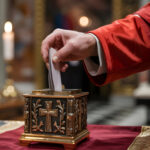- Written by Compudata
- Published: 14 May 2025

When the College of Cardinals gathers to elect a new Pope—as they did last week—the process is shrouded in a level of secrecy that has captivated the world for centuries. This event, known as the papal conclave, is a masterclass in information control. Beyond the tradition and ceremony lie powerful lessons in security that businesses can, and should, consider to protect their business’ assets.
At Compudata, we believe that proactive business technology support isn't just about the latest software; it's about smart strategies. And sometimes, the most enduring strategies have historical roots. Let's explore what the ancient art of the conclave can teach us about modern-day data protection.
With Key: The Origins of Conclave Security
The term conclave itself comes from the Latin "cum clavis," meaning "with key." This isn't merely symbolic. The practice of isolating the cardinals during a papal election was formally established by Pope Gregory X in 1274. The rules were stringent and purposeful. They include:
- Strict seclusion - Cardinals were to meet in absolute secrecy, shielded from outside interference.
- Limited personnel - Each cardinal was permitted only a minimal number of attendants.
- Encouraging resolution - Rations were provided through a window, and if a decision wasn't reached within eight days, the provisions were reduced to just bread, water, and wine—a clear incentive to proceed diligently.
These measures served three key purposes: fostering an environment for spiritual discernment, encouraging a timely decision, and, crucially, ensuring secrecy and foiling any attempts at espionage or undue influence. Once the doors were sealed, the only communication with the outside world was the famous smoke signal indicating the election's progress.
While adherence to every detail has varied over nearly 750 years (imagine the logistical challenges), the core commitment to security has remained. For instance, while cardinals historically stayed within the Apostolic Palace, often in makeshift cells around the Sistine Chapel, Pope John Paul II instituted in 1996 that they would be housed in the purpose-built Domus Sanctae Marthae guesthouse within Vatican City; a modern facility designed for security and efficiency during the conclave.
These time-honored security protocols are still in effect today, now augmented by modern technology to create a comprehensive defense for the integrity of the deliberations.
The Double-Edged Sword for Conclave Security
In our hyper-connected world, maintaining conclave-level secrecy presents new challenges. Yet, the Vatican adapts. While specific security details are understandably confidential, certain measures are known:
- Electronic sweeps and controls - The entire area is meticulously scanned for unauthorized electronic devices before the conclave begins, and attendees are screened.
- Signal disruption - Though Vatican City has Internet access, strategic use of signal jamming technology in sensitive areas helps prevent illicit communication via cellular or Wi-Fi signals.
- Countering advanced surveillance - Today's satellites can capture incredibly detailed images, and AI can even analyze video for lip-reading. The Vatican mitigates these risks by conducting deliberations within the secure, opaque confines of structures like the Sistine Chapel. Windows are often specially treated to prevent visual breaches.
- Physical security - The Pontifical Swiss Guard, the Vatican’s de facto military force since 1506 also protect the conclave, easily recognized by their vibrant Renaissance-style uniforms. This is a design sometimes attributed to Michelangelo, though historical consensus varies. These highly trained guards, equipped with modern firearms, work alongside the Gendarmerie Corps of Vatican City State (the police force) which utilizes extensive CCTV surveillance and a sophisticated command center to ensure physical security.
This blend of ancient tradition and modern technological defense ensures the conclave remains an impressively secure process.
From the Walls of St. Peter’s Basilica to Your Office
While most businesses don't operate with the global profile of the Vatican, the principles underpinning its security are universally applicable to protecting your organization’s vital information. Here are some comparisons to the papal conclave and your security needs for your business:
- Robust access controls (the sealed Sistine Chapel) - Just as the Sistine Chapel is sealed to all but the voting cardinals, your business must implement strong access controls. This means ensuring only authorized individuals can access sensitive physical locations (like server rooms) and digital assets (databases, confidential files, proprietary software).
- The principle of least privilege (only Cardinals vote) - In a conclave, only the cardinals directly involved in the election have access to the critical information and processes. This mirrors the principle of least privilege, a cornerstone of modern cybersecurity. Employees should only be granted access to the specific data and systems essential for their job functions, minimizing potential exposure if an account is compromised.
- Secure data disposal (burning the ballots) - After each round of voting, the cardinals' notes and ballots are burned, ensuring the secrecy of their choices. Similarly, businesses must implement secure data destruction practices for outdated technology and sensitive documents. Simply deleting files or discarding old hard drives isn't sufficient to prevent data breaches.
Protecting your business intelligence, client data, and operational integrity is important for any organization. At Compudata, we specialize in providing proactive business technology support tailored to the unique needs of our clients. If you’re ready to apply proven security principles, inspired by centuries of practice, to your own business, we invite you to learn more. Reach out to Compudata at 1-855-405-8889 to discuss how we can help fortify your defenses.
Comments Off on Vatican City or Fort Knox?
Posted in Blog, Security
Tagged Current Events, Privacy, Security
